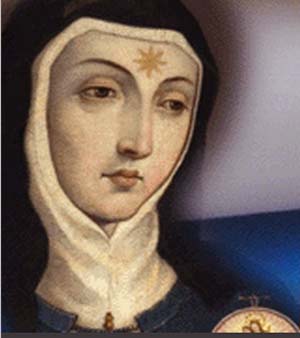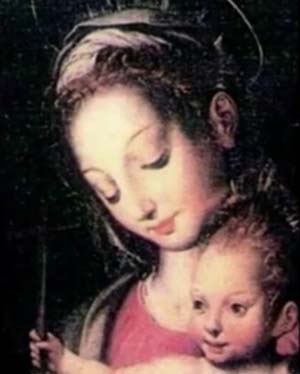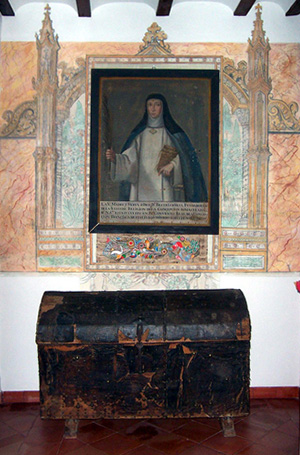 |
Our Lady of Good Success
Beatriz da Silva – Part I
The Founder of the Conceptionists
Marian T. Horvat
The life of Beatriz da Silva e de Menezes (1424-1492) is filled with marvels. Reading about her, I felt like I had stepped back through the centuries to the times when God rewarded faith with miracles and Heaven seemed closer to earth. Beatriz da Silva has many titles: A lady in waiting in the Spanish Court, lay sister for 30 years, and the most glorious, foundress of the Order of the Immaculate Conception, also known as the Conceptionists, a branch of the Franciscan Order.

The Founder of the Conceptionists |
Her life has a special significance to us because she was the spiritual mother of Mother Mariana de Jesus Torres, born some 125 years later. When you read The Admirable Life of Mother Mariana, you see that Mother Beatriz appeared often to Mother Mariana, especially during her great sufferings in the Convent and at the end of her life, foretelling many things about the Order and that particular Convent in Quito, which she told her would last until the end of the world.
There is a second significance: Her story reminds us to confide in the promise of Our Lady for our times, the promise she made at Fatima and at Quito that she will intervene in History to bring the triumph of her Immaculate Heart. For most of her life, Beatriz had to trust in a promise of Our Lady. When Beatriz was a young woman, Our Lady told her she would found an Order in honor of her Immaculate Conception. She had to hold to this promise, believe in it and confide in Our Lady almost her whole life. Only at its end, at 60 years of age, did that promise become a reality.
Her early life
Beatriz da Silva was born in 1424 in Ceuta in north Africa, then a Portuguese territory. She was the daughter of Ruiz Gómez da Silva and Dona Isabel de Meneses, who was related to the royal houses of Spain and Portugal. Her maternal grandfather was Pedro de Meneses, Count of Viana, who had distinguished himself in the 1415 Conquest of Ceuta for the Portuguese Crown. To reward the Count for his fealty and bravery, the King gave him his daughter in marriage, thus uniting the two families.

Beatriz posed as the Virgin in this painting
|
Her parents entrusted the education of their 11 children to the Franciscans, who marked their souls with a special love for the Immaculate Conception. Two of her brothers, João and Amadeo, took the habit of St. Francis. Amadeo, who founded a new branch of the Minor Friars and headed a reform movement called the Amadeists, would, like his sister, be raised to the altars for the glory of his family and God.
In 1437 the King of Portugal appointed her father alcaide (mayor) of Campo Maior near the Spanish border, and the family moved to a castle near that ancient rustic village. Even as a young girl, Beatriz was renowned for her angelic beauty. When her father contracted an Italian artist to paint a picture of the Virgin for the chapel in his castle, the artist told him the best model for the Virgin would be his daughter.
In obedience to her father, Beatriz consented to pose for the painter. But in her modesty she would not raise her eyes in front of the painter. This resulted in a painting known until today as “The Virgin of the Closed Eyes,” which hangs in a church in Campo Maior.
The court of Castile
In 1447, Juan II of Castile married the Infanta Isabel, daughter of King Afonso V of Protugal and cousin of Beatriz. The new Queen of Castile chose Beatriz as her first lady- in-waiting. And so, Beatriz left Lisbon, where she was already a member of the Infanta’s court, to accompany the new Queen to the Castilian court in Tordesillas.
According to biographers of the time, Beatriz was “marvelously beautiful, even dazzling.” Her beauty was complemented by her outstanding virtue. Her biographers tell us she was “prudent, affable, intelligent, composed and most gentile.” (1) She was especially distinguished for her great purity and love for the Immaculate Virgin.
At first, Queen Isabel was proud of the stir her cousin’s beauty and virtue raised in the court, which was plagued with intrigues and the frivolities of the time. The Queen wanted her cousin with her constantly, and the young woman exerted a good influence on the temperamental Queen, prone to excesses. The beauty and nobility of spirit of the young Portuguese noblewoman won the admiration of all around her, and many courtiers sought her attention.

The chest where Beatriz was buried, today in the upper cloister of the Toledo Convent |
It was the intrigues of a resentful suitor whose advances Beatriz had resisted that changed the feelings of the Queen from love to hatred. The rejected courtier insinuated to the Queen that Beatriz was a rival for the King’s love. The Queen became insanely jealous of her cousin, to the point she could no longer bear her presence.
One day, the Queen asked Beatriz to accompany her to a cellar in the castle. Arriving there, she ordered Beatriz to open a large chest. Moved by turbulent passion, the Queen pushed her in the chest, closed the lid and locked it with a key.
Three days passed and Don João de Meneses, the uncle of Beatriz, who was in the service of the Castilian King, became increasingly concerned about the disappearance of his niece. Knowing the great envy the Queen harbored against Beatriz, he feared the worst.
Finally, in response to his persistent questioning, the Queen told him, “Come and see her.” She led him to the chest where Beatriz was interred and told him to open it, thinking to find a body already disfigured by death. Instead, they found Beatriz alive, more beautiful than ever, her face shining with light.
Destitute of all human help, Beatriz had entrusted herself to the Virgin Mary, who appeared to her dressed in a white habit and scapular and a sky blue mantle with the Child Jesus in her arms. After announcing to her that she would be freed, Our Lady told her that she would found an Order dedicated to the honor of the mystery of her Immaculate Conception, and that the nuns should wear the same blue and white habit that Beatriz saw her wearing in the apparition. Beatriz offered herself to Our Lady as her slave, made a vow of virginity, and promised to fulfill the mission she had been given. It was at this moment – when all seemed lost and her life over – that the first seeds of the Order of the Immaculate Conception were sown.
A lay sister in Toledo
Although she was now free, Beatriz still feared the irrational wrath of her cousin the Queen. Receiving permission to leave the court, she set out, accompanied by two maidens, for Toledo for the Convent of San Domingo el Real. She had determined that no one should ever again see her face, which she covered with a white veil that she wore for the rest of her earthly life.

St. Francis and St. Anthony of Lisbon consoled her on her way to Toledo |
Along the road to Toledo, she met two Franciscan friars. At first, she feared that they had been sent at the Queen's order to confess her before she was imprisoned or her life was taken. But the friars, one with strong Portuguese features, greeted her affably and comforted her, telling her not to fear for she would be a grand senora and the mother of many children. She protested that she would never marry because she had made a vow of purity to the Queen of Heaven. They only replied, “What we have said will come to be.”
When they arrived at the inn, the two mysterious friars disappeared. Filled with a great peace of soul and an understanding of certain supernatural realities, she believed firmly that Our Lord had sent St. Francis of Assisi and St. Anthony of Lisbon to console and instruct her.
For 30 years, she lived a cloistered life in the Convent of San Domingo el Real. Although she followed the life and fule of the Cistercian nuns, she did not take their habit. Thus began a new stage in her life as a senora de piso, a laywoman who lived inside the convent without making a formal profession. During this time, Dona Beatriz became renowned for her hidden life of prayer, sacrifice and charity. Her special devotions, which would characterize her future Order, were to the Holy Eucharist, the Passion of Our Lord and the Immaculate Conception of Our Lady.
These were the difficult years of the wait. She had renounced her luminous beauty, her social position, her fortune and the possibility of making an enviable marriage. Instead, she chose to remain enclosed in a convent as a lay sister, waiting confidently to carry out the mission entrusted to her by the Immaculate Virgin. Rarely has a founder been asked to make so prolonged a wait to carry out her mission.

A providential friendship begins with Isabel la Catolica
|
Despite the seeming impossibility of the task, Divine Providence was preparing a way for Beatriz to fulfill her vocation. In 1496 Queen Isabel, her persecutor, died, and her daughter, Isabella la Catolica, became the new Queen of Castile. The daughter took a strong interest in Beatriz and would play an important role in the foundation of the Conceptionist Order.
Isabel had been crowned in 1474. In 1479 she entered triumphant into Toledo, and to fulfill her promise made in the Battle of Toro, she began the construction of a church to St. John the Evangelist. The site chosen was near the convent where Beatriz was staying. The young Queen began to visit Beatriz and was deeply impressed by her goodness and virtue. According to the early biographers, Queen Isabel was the only person for whom Beatriz lifted her veil to permit her to see the exquisite features that had driven her mother mad with jealously.
Thus began a close collaboration between Beatriz and Isabella la Catolica, a fortuitous alliance that would give rise to the new Order dedicated to the Immaculate Conception.
Continued
1. The early biographers are listed here

Posted February 10, 2012

Related Topics of Interest
 Beatriz da Silva: Part 2 Beatriz da Silva: Part 2
 Beatriz da Silva: Part 3 Beatriz da Silva: Part 3
 The Brave Boast of Pedro de Meneses The Brave Boast of Pedro de Meneses
 The Prophecies Approved by the Church The Prophecies Approved by the Church
 Impressions of Our Lady of Good Success Impressions of Our Lady of Good Success
 The Search for Garcia Moreno's Body Ends The Search for Garcia Moreno's Body Ends
 The Mission of Mother Mariana The Mission of Mother Mariana
 A Soldier Converts - Autobiography of Fr. Pereira A Soldier Converts - Autobiography of Fr. Pereira
 The Original Statue of Our Lady in Madrid The Original Statue of Our Lady in Madrid
 Novena to Our Lady Novena to Our Lady

Related Works of Interest
|
Our Lady Good Success | Home | Books | CDs | Search | Contact Us | Donate

© 2002- Tradition in Action, Inc. All Rights Reserved
|
 |
|